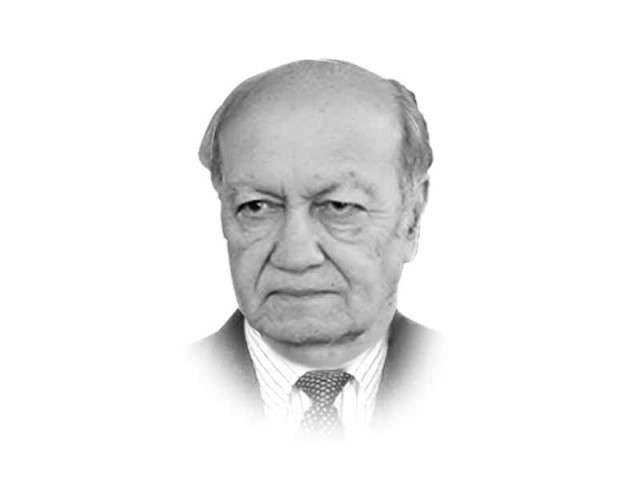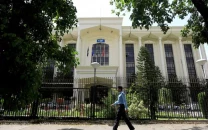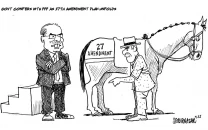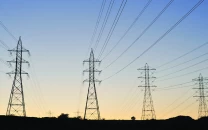Pakistan’s multiple woes
The failure of US policy in Afghanistan is reflected in its frustrations against Pakistan

The writer is a retired lieutenant general of the Pakistan Army and a former federal secretary. He has also served as chairman of the Pakistan Ordnance Factories Board

For the US, too, there were manifold advantages in having Pakistan as an ally. The sale of major weapon systems amortises the cost of development and maintenance, creates dependence of recipient countries for years on the producer and generates an additional source of income that keeps the production line functional. The West and Russia have used arms supplies as a means to leverage their foreign and defence policy goals. This aspect has been evident as we have remained beholden to the US and its dictates until 1965 when it decided to cut off military aid and refused to sell weapons. Since then, we did manage to diversify and China is now a primary and most reliable source of supply for weapons and equipment. However, for state-of-the-art and high technology items, there is still no substitute for the US. The JS-17 Thunder multi-role fighter aircraft has been a remarkable success story of our cooperation with China and embraces cutting-edge technologies at an affordable cost, but the aircraft is meant to complement the F-16 and is a replacement of the F-7 and Mirage series.
There were several other periods when the US has withheld or denied Pakistan the F-16 aircraft. The worst example of this was when it revived sanctions in 1988 and even blocked the amount that had been paid for the aircraft.
Relations between the US and Pakistan are once again passing through a difficult phase that could have serious consequences for the security and stability of the region. The intense hostility displayed by Congress indicates how effectively India and other anti-Pakistan lobbies have succeeded in prejudicing the American legislative body’s attitude towards Pakistan. The failure of US policy in Afghanistan is reflected in its frustrations against Pakistan. The presence of the Taliban shura in Balochistan and that of the Haqqani group in Fata has been a sour point with the Americans and Afghans. Pakistan’s repeated denials that it is not patronising the Taliban have few takers in the international community. This provides the Afghan leadership with the opportunity to make Pakistan the scapegoat for its own failures and allows India to gain a greater foothold and earn the goodwill of the Afghan people.
Adding to our woes, President Obama is believed to have threatened Nawaz Sharif with dire consequences if we do not change our policy of supporting the Taliban and other militant groups that are destabilising Afghanistan and hurting India’s interests. According to President Obama’s recent remarks, Pakistan’s future is fairly bleak describing it as a “disastrously dysfunctional country”.
It is common knowledge that in Pakistan, the military dominates key foreign, defence and security policy issues. Foreign heads of government and leaders give the army chief the importance that his position commands in our national power structure. But with this standing, the military also has to face criticism. All regional countries apart from China are accusing us of providing support to the Taliban, the Haqqanis, the Jaish-e-Mohammad and the Lashkar-e-Taiba. During President Rouhani’s recent visit, we were hoping to make amends with Iran, but this attempt received a serious setback when a military spokesperson tweeted about Iranian territory being used by Indian spies.
The systematic and coordinated campaign of maligning Pakistan can have serious ramifications for Pakistan-US relations and our global image. The excessive security-oriented lens through which the US views its relations with Pakistan has grave limitations. The imbalance in this approach comes at a heavy cost to the Pakistani people and society that the US conveniently overlooks. How do we navigate in this hostile environment when Pakistan is torn by deep internal dissensions and civil-military disharmony? Imran Khan’s crusade to dislodge the government may be driven by a combination of personal ambition and altruistic considerations, but if carried too far, has the potential of placing the country in a chasm. Already our civil and military leadership, in pursuing their narrow institutional interests, have exacerbated the country’s growing political and economic problems.
Several steps on the external and internal fronts will have to be undertaken to reverse the free fall. Afghanistan and Pakistan should stop the use of proxies against each other. This will have to be done in a transparent manner so that confidence between the two countries is restored and militant groups are genuinely weakened. Afghanistan has tried to seek a closer proximity to India to countervail our association with the Taliban. This impression needs to be erased by pursuing a more transparent policy vis-a-vis the Taliban and improving relations with the Afghan government and people. Pakistan has made serious efforts at bringing the Taliban to the negotiating table, but they are not interested in peace talks as of now. Without genuine commitment of the Afghan security forces and close cooperation between Afghanistan and Pakistan, it will not be possible to fight terrorism and insurgency effectively. Furthermore, inefficient border management between the two countries is harming the interests of both. The several entry and exit points need to be better managed and regulated in accordance with internationally-accepted norms. If concrete steps are not taken to cooperate on security issues at the regional level, increased instability will follow. Already the Taliban are taking advantage of the infighting and paralysis of the Afghan government. Strained relations between Afghanistan and Pakistan provide them another area to exploit to their advantage. The way out is to reframe our engagement with both the US and Afghanistan, where apart from security cooperation, expanded mutual trade, expediting work on energy corridors and unlocking Pakistan’s potential as a hub linking central Asia and Iran are the need of the hour.
Published in The Express Tribune, May 4th, 2016.
Like Opinion & Editorial on Facebook, follow @ETOpEd on Twitter to receive all updates on all our daily pieces.















COMMENTS
Comments are moderated and generally will be posted if they are on-topic and not abusive.
For more information, please see our Comments FAQ